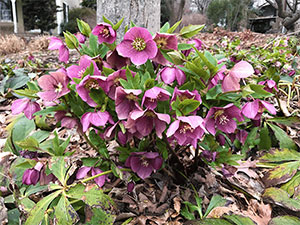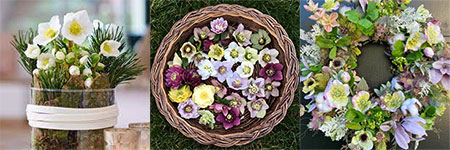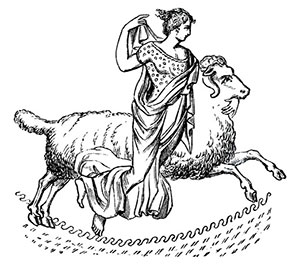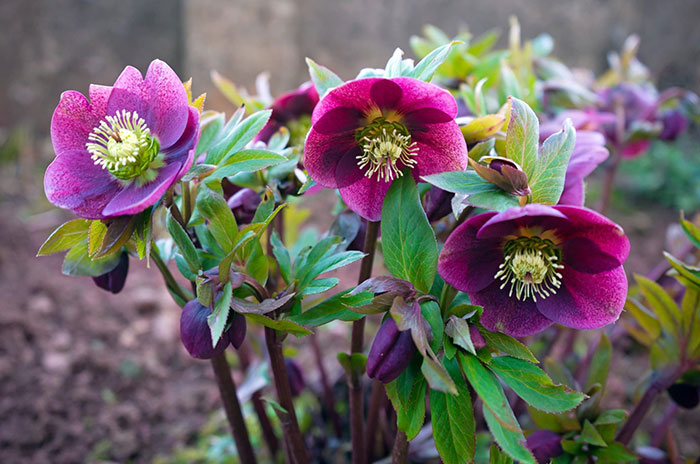Hellebore Flower Symbolism Facts & Meaning: Zodiac, Superstitions, Dreams, and Legends
I
Hellebore Flower Facts

The first time a person may have heard of “Hellebore”, without a conscious thought on it, will somehow relate the word with something that is negative, gloomy, or even fatalistic. True enough, “Hellebore” may be a beautiful flower on the outside, but beware even just touching it, as it is poisonous. In fact, it is a toxic plant at every part, both to humans and animals.
From the Greek word helein, meaning “to kill” and bora, meaning food, Hellebore is from the family Ranunculaceae with approximately 20 species. Hellebore is from the genus Helleborus, an herbaceous or evergreen enduring flowering plant. Primarily a native of South and Central Europe, mainly, Germany, Italy and Austria. It survives a range of habitats, from open mountains to shaded woodlands making it a favorite of cultivars.
The most commonly known varieties of this plant are:
Helleborous niger also known as “Christmas Rose” or “Black Hellebore”. Helleborous orientalis “Lenten Rose”, “Lenten Hellebore” or “Oriental Hellebore” or referenced as black Hellebore by ancient Greek myth. Helleborous viridis “Green Hellebore” or “Bear’s Foot”. Helleborous argutifolius “Corsican Hellebore”. Helleborous foetidus “Stinking Hellebore” or “Setterwort”.

II
Hellebore Flower Uses
Though the flower is regarded as poisonous, it is still customarily used for holiday decorations, flower arrangements, and table centerpieces especially in Europe. It is as well widely cultivated potted garden plant.
In modern times, it is still yet to be studied whether the plant can actually be used for medicinal purposes, due to its toxicity. But it has been known to treat nausea, worms, colds, constipation, kidney infections, and irregular menstruation. It can also cause miscarriage and has abortive properties. But since the times of ancient Greek, it was widely known to be a cure for hallucinations, delirium, and lunacy.

III
Hellebore Flower History
Alexander the Great was said to have been betrayed by his trusted man, the royal cupbearer using Hellebore poisoning.
The Greeks have also used Hellebore as poison on the arrows that they used in battle. Moreover, it was said that the Siege of Kirrha (585 B.C.), known as the first sacred war, is considered a chemical warfare, where the water system was poisoned with crushed Hellebore causing diarrhea.
In the field of medicine, Hippocrates in his study has as well mentioned the efficacy of Hellebore in treating stomach pain. Apart from that, it was said that Hippocrates gave Hellebore as prescription for insanity and madness. However, there were stories that it was actually a white Hellebore or false Hellebore that was used by Hippocrates.
Another account of Hellebore being used as a medicine was with Melampus of Pylos. His story being in the middle of myth and reality, as to the accounts being given of him. But the story goes that he used the Hellebore plant to heal the daughters of King of Argos from insanity. The princesses were said to be running around the kingdom shouting and naked prior.
Melampus was also said to have healed a man with prostate problems. The man as a child witnessed his father cut open an animal, and from then on had bad connections with blood. The story tells how the father, upon seeing the fright on his child’s face, decided to instead struck the knife to a tree to hide it from the child. Story goes that a nymph was hit and punished the child with prostate problems . It was Melampus with his power to talk to animals that he gained information of a cure. Eventually, the man was healed and was able to have a child of his own.
IV
Hellebore Flower Positive Symbolism

In modern times, it has become a symbol of peacefulness, quietude, and calmness. It also symbolizes purity. It can be placed in a bouquet of flowers, and it will just compliment all the other flowers around it. In its quietness and calmness, it exudes beauty and purity, without drawing competition for attention.
V
Hellebore Flower Negative Symbolism

In the Victorian era, Hellebore symbolized delirium, as based from the “Language of Flowers”. Considered poisonous, it also suggests negative symbolisms such as representing impropriety, anxiety, and stress.
VI
Hellebore Flower Cultural Symbolism
Known as the Christmas Rose, this originated from a story when a little girl came to visit the newborn baby Jesus in the manger. The little girl cried because she had nothing to offer the child Jesus. It was said that from her tears that fell on snow, bloomed the Hellebore. It has then been associated with Christmas, and more so, since Hellebores bloom in the Christmas season.
VII
Hellebore Flower Zodiac Sign

Determination which is a characteristic of Capricorns fits perfectly with the Hellebores characteristic as well. It blooms in winter while there’s still snow, showing perseverance and determination, much like its zodiac counterpart.
VIII
Hellebore Flower in Dreams
As the flower connotes a negative characteristic, dreaming of it as well has a negative meaning. It means of danger looming in your life. It can also mean deceit from someone close to you.
IX
Hellebore Flower Omens and Superstitions
The plant is something ever present in people practicing necromancy and apothecaries. Especially of those with European ancestry that believe in its magical properties, as evident in their folklore.
Even in modern day witchcraft, it is highly in demand for potion making, and used as well in ointments. It is a main ingredient in the mythical “flying ointment” used by ancient witches.
Hellebore is also known to be used in driving out bad spirits and elements to cleanse properties.
X
Hellebore Flower Mythology and Folklore
Hellebore is referenced to “food of Helle”, Helle being the Goddess of Hellespont, in Greek mythology, for which the name Hellespont was derived.


